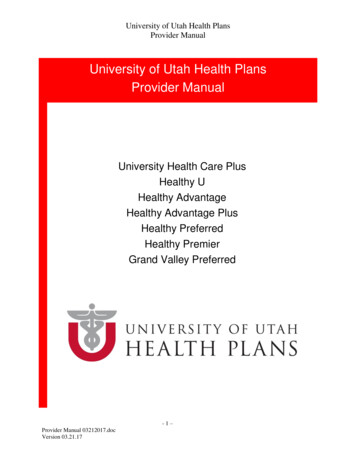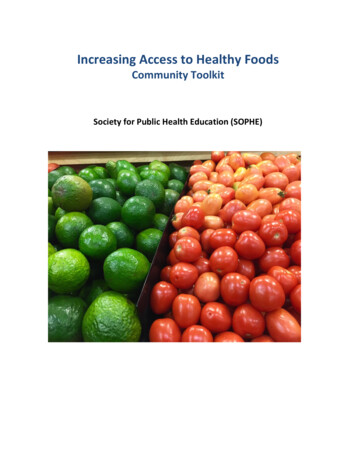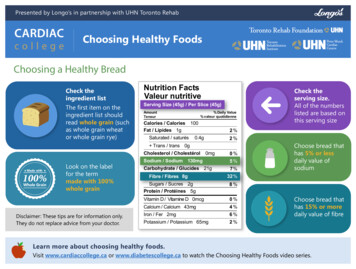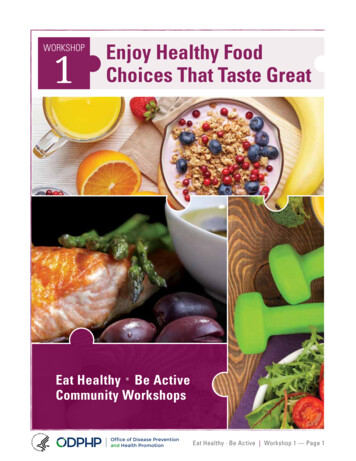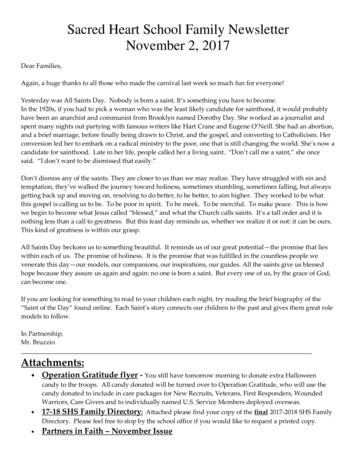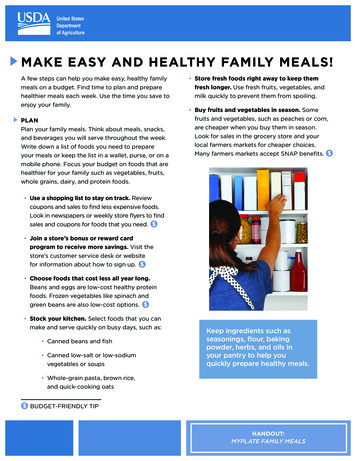
Transcription
United StatesDepartmentof AgricultureMAKE EASY AND HEALTHY FAMILY MEALS!A few steps can help you make easy, healthy familymeals on a budget. Find time to plan and preparehealthier meals each week. Use the time you save toenjoy your family.PLANPlan your family meals. Think about meals, snacks,and beverages you will serve throughout the week.Write down a list of foods you need to prepareyour meals or keep the list in a wallet, purse, or on a Store fresh foods right away to keep themfresh longer. Use fresh fruits, vegetables, andmilk quickly to prevent them from spoiling. Buy fruits and vegetables in season. Somefruits and vegetables, such as peaches or corn,are cheaper when you buy them in season.Look for sales in the grocery store and yourlocal farmers markets for cheaper choices.Many farmers markets accept SNAP benefits. mobile phone. Focus your budget on foods that arehealthier for your family such as vegetables, fruits,whole grains, dairy, and protein foods. Use a shopping list to stay on track. Reviewcoupons and sales to find less expensive foods.Look in newspapers or weekly store flyers to findsales and coupons for foods that you need. Join a store’s bonus or reward cardprogram to receive more savings. Visit thestore’s customer service desk or websitefor information about how to sign up. Choose foods that cost less all year long.Beans and eggs are low-cost healthy proteinfoods. Frozen vegetables like spinach andgreen beans are also low-cost options. Stock your kitchen. Select foods that you canmake and serve quickly on busy days, such as: Canned beans and fish Canned low-salt or low-sodiumvegetables or soupsKeep ingredients such asseasonings, flour, bakingpowder, herbs, and oils inyour pantry to help youquickly prepare healthy meals. Whole-grain pasta, brown rice,and quick-cooking oats BUDGET-FRIENDLY TIPHANDOUT:MYPLATE FAMILY MEALS
PREPAREDo some tasks in advance. Make meals on theweekends when you have more time. Prepare extraand freeze some meals to use later in the week. Findways to save yourself time during the weekdayswhen everyone is busier. Look for shortcuts. Grated, chopped, orpre-washed foods cost more but often savetime in the kitchen. Compare prices on theseitems. Look for sales on easy to prepare foodssuch as frozen veggies or mixed salads. Prepare a meal that kids and adults willenjoy. Try not to make a separate mealfor each person. If your child likes plainvegetables, meat, rice, or noodles, set someaside before you add other ingredients. Serve no-cook meals. Make simple mealslike salads with canned tuna and beans orcold sandwiches with lean meats and slicedvegetables. Find information about mealplanning, shopping, and creating healthy mealsat ChooseMyPlate.gov/budget/index.html. Cook when you have more time. On theweekends, make soups, stews, or casseroles. Cooklarger amounts of lean ground beef or turkey anduse some for chili or spaghetti later in the week.Freeze some of your meals for really hectic days.Farmers markets often carry foods grown locally.Find a local market near you by visiting:search.ams.usda.gov/farmersmarkets Look for recipes with fewer ingredients.Choose recipes with only a few ingredientsthat can be prepared quickly. VisitWhatsCooking.fns.usda.gov for ideas. Involve kids in family meals. Let children helpwith simple tasks like washing fruits, choosingthe veggies, setting the table, or measuringfoods. On busy weekdays, give everyone atask to help you get dinner on the table.November 2014Food and Nutrition ServiceUSDA is an equal opportunityprovider and employer.
United StatesDepartmentof AgricultureMAKE HALF YOUR GRAINS WHOLE GRAINSThe grains group includes breads, cereals, rice, andpasta. All grains are made with some of the grainkernel but whole grains include the entire kernel.When parts of the grain are removed, it is called arefined grain. Enriched grains have nutrients addedback in. Both whole grains and enriched grainsprovide good nutrition. Whole grains often havemore fiber, which helps to keep your body regular.Adults and children who need 2,000 calories shouldeat about 6 ounces of grains each day. Three of Two slices of 100% whole-wheat bread in asandwich (counts as 2 ounces of whole grains). 1 cup of cooked rice (countsas 2 ounces of grains). One medium corn tortilla (countsas 1 ounce of grains).those ounces should be whole-grain.Serve a variety of grains such as: 1 cup of 100% whole-wheat flakes(counts as 1 ounce of whole grains).TI P S O N E ATI N G WH O LE G R AI N SMake at least half your grains whole grains. Usewhole-grain bread in sandwiches, mix brown ricewith vegetables, and use whole-wheat pasta indishes like spaghetti.Eat whole grains to keep you on track. Many wholegrains provide health benefits, like fiber, which helpsto keep the body regular.Check the package. Look on the package andingredient list for the words “100% whole grain”or “100% whole wheat.” Some grains say “bran” or“100% wheat” and may not contain any whole grain.Brown or dark colors are not a sign that foods aremade with whole grains.Try whole grains for breakfast! Choosewhole-wheat cereal, oatmeal, or whole-grain waffles.What about whole-grain snacks? Try whole-graincereals such as shredded wheat or toasted oats.Popcorn is a great snack, when made with little orno butter or salt.Give kids whole-grain foods without the extras.Many grain foods such as cookies, cakes, pies, anddonuts have a lot of solid fats and added sugars.Serve these foods less often.To find the right amount of grains for members of your family,visit food-plans.html or SuperTracker.usda.gov.HANDOUT:MYPLATE FAMILY MEALS
United StatesDepartmentof AgricultureSTIR-FRIED GREENRICE, EGGS, ANDTURKEY HAMCOOK TIME: 1 hour and 20 minutesMAKES: six 1-cup servingsINGREDIENTS: 1¾ cups brown rice, long-grain, regular, dry ⅓ tsp salt ¾ cup frozen chopped spinach, thawed, drained 6 large whole eggs, beaten 1 tablespoon vegetable oil ½ cup extra-lean turkey ham, diced ¼” (2 ounces) ¼ cup fresh green onions, diced 1 teaspoon sesame or vegetable oil 1 teaspoon low-sodium soy sauceNUTRIENTS PER SERVING:Calories 238, Protein 9 g, Dietary Fiber 3 g, Total Fat 7 g,Saturated Fat 1 g, Cholesterol 74 mg, Sodium 313 mg.(Team Nutrition, Recipe for Healthy Kids: Cookbook for Homes)DIRECTIONS:1. Combine brown rice and 4½ cups water in a large pot and bring to a boil. Turn heat down to low. Cover andcook about 30-40 minutes, until water is absorbed. Fluff with a fork. Add salt to rice. Mix well. Set aside. (Arice cooker may be used with the same quantity of brown rice and water.)2. Drain water from spinach by squeezing thawed spinach with hands. Set aside.3. Whisk together eggs and 1 tablespoon of water. Cook half of the eggs in a large nonstick skillet coated withnonstick cooking spray. Remove eggs from skillet to cool. Chop cooled eggs and set aside. Reserve theremaining eggs for step 5.4. Heat vegetable oil in a wok or a large nonstick skillet over high heat. Add ham and cook for 2 minutes oruntil ham begins to brown.5. Reduce heat to medium. Add brown rice and toss to mix. Add remaining eggs. Stir for 5 minutes or untilegg is fully cooked. Add green onions, spinach, chopped egg, sesame oil, and soy sauce. Stir well. Cookuntil thoroughly heated. Serve hot.What’sCookingU S DA M I X I N G B OW LFor more recipes visitWhatsCooking.fns.usda.gov.November 2014Food and Nutrition ServiceUSDA is an equal opportunityprovider and employer.
United StatesDepartmentof AgricultureG E T YO U R DAI RYDairy foods offer important nutrition for you andyour family. Choose low-fat or fat-free dairy foodsto get the calcium and vitamin D your body needsfor strong teeth and bones. If you can’t drink milk,try calcium-fortified soymilk (soy beverage), low-fatyogurt, cheese, or calcium-enriched foods. Adultsand children who need 2,000 calories daily shouldeat or drink about 3 cups of dairy each day. ½ cup of calcium-fortified soymilk withyour meal (counts as ½ cup of dairy) 1 cup of low-fat plain yogurt(counts as 1 cup of dairy) 1 slice (1 ounce) of low-fat cheddar cheeseon a sandwich (counts as ½ cup of dairy).Serve different types of dairy such as: 1 cup of low-fat milk on cereal(counts as 1 cup of dairy)TI P S TO G E T YO U R DAI RYMake the switch to low-fat and fat-free milk. Somekids and adults may need to make the change fromfull-fat dairy slowly. First, switch from whole to 2%milk (reduced-fat). Later, change to low-fat (1%) orskim (fat-free) milk.Keep dairy food on your shopping list. Keep alist of dairy foods that your family will eat such aslow-fat milk or yogurt. Check online and look atyour grocery receipt for coupons to help you savemore on dairy foods. Use low-fat plain yogurt for toppings and sauces.Some foods are not part of the dairy food group,like cream, sour cream, cream cheese, and butter.They are high in solid fat and have little or nocalcium. Add low-fat or fat-free milk to your coffeeor tea instead of cream. Use low-fat yogurt insteadof sour cream for cooking.If you have trouble drinking milk, try soymilk (soybeverage). If you don’t or can’t drink cow’s milk,fortified soymilk is a great choice.Add a little cheese to meals and snacks. Lookfor lower fat cheeses like part-skim mozzarella, orreduced-fat Swiss or cheddar. Serve low-fat choiceswith foods like sliced cucumbers, apples, or 100%whole-grain crackers.Show kids that dairy is important. Make a pointto eat and drink dairy foods daily. Chocolate milk,flavored yogurt, frozen yogurt, and pudding havecalcium but also a lot of added sugar. Serve themon special days and less often. BUDGET-FRIENDLY TIPTo find the right amount of dairy foods for members of your family,visit food-plans.html or SuperTracker.usda.gov.HANDOUT:MYPLATE FAMILY MEALS
United StatesDepartmentof AgricultureBATIDO SMOOTHIETOTAL TIME: 10 minutesMAKES: 4 servingsINGREDIENTS: 2 cups papaya chunks, fresh or frozen* 2 bananas, overripe and sliced 1 cup yogurt, plain low-fat** 1 cup ice cubesDIRECTIONS:1. Put all the ingredients in the blender.2. Put the lid on tightly. Turn the blender to amedium setting and blend about 1 minute untilthe ice is chopped and the mixture is smooth.3. Serve right away, or cover and refrigerate up to4 hours.*Frozen or fresh strawberries, blueberries, orraspberries can be used in addition to orinstead of papaya.**Low-fat milk, soy, rice, almond, or coconutmilk can be used instead of yogurt.What’sCookingU S DA M I X I N G B OW LFor more recipes visitWhatsCooking.fns.usda.gov.NUTRIENTS PER SERVINGS:Calories 118, Protein 4 g, Dietary Fiber 3 g, Total Fat 1 g,Saturated Fat 1 g, Cholesterol 4 mg, Sodium 46 mg.November 2014Food and Nutrition ServiceUSDA is an equal opportunityprovider and employer.
United StatesDepartmentof AgricultureLOO K FO R LE AN PROTE I N FOO DSProtein foods include meat, poultry, fish and otherseafood, beans, eggs, nuts and seeds. Most of useat enough protein every day. Eating both animaland plant sources offers variety and can help youstay within your budget. Adults and children whoneed 2,000 calories daily should eat about 5½ounces of protein foods each day. ½ cup cooked black beans (countsas 2 ounces of protein) One half of a small chicken breast(counts as 2 to 3 ounces of protein)Include protein foods such as: One whole egg (counts as 1 ounce of protein)TI P S O N CH OOS I N G LE AN P ROTE I N FOO DS :Trim the extra. Much of the fat in chicken and turkeyis in or under the skin. Remove skin and fat for aleaner meal. Compare prices for lean meats with thefat already trimmed or poultry with the skin removed. Add a few nuts to your meal or snack. Nuts are agood source of protein but can be high in calories.Keep your servings small—1 ounce of almonds isabout 20 to 24 nuts. Try peanut butter on appleslices, celery, or 100% whole-grain crackers.Fry foods less often. Bake, broil, or microwave leanbeef, pork, chicken, and turkey. You can use a lotless oil by cooking in an oven or microwave. Makeprotein foods with little or no added fat.Try eating seafood at least 2 times per week. Buyfresh or canned fish, like tuna or salmon, when it‘s on sale. Canned fish usually costs less.Buy choices that fit your budget. Serve low-costprotein foods like beans, peas, and eggs to savemoney. Stock up on canned beans and peas whenthey are on sale. Keep your food safe! Wash your hands, utensils,and cutting boards before and after contact withraw meat, poultry, seafood, and eggs. BUDGET-FRIENDLY TIPTo find the right amount of protein foods for members of your family,visit food-plans.html or SuperTracker.usda.gov.HANDOUT:MYPLATE FAMILY MEALS
United StatesDepartmentof AgricultureMEDITERRANEAN CHICKENAND WHITE BEAN SALADTOTAL TIME: 20 minutesMAKES: 4 servingsINGREDIENTS: 1 cup cooked chicken thighs, skinless,diced into ½-inch pieces 1 (15.5-ounce) canned white beans,low-sodium, drained 1 cucumber, peeled, diced into ½-inch pieces ¼ onion, peeled, chopped into ½-inch pieces 2 tablespoons vegetable oil ¼ cup lemon juice 1 tablespoon dried or fresh basil ¼ teaspoon salt ¼ teaspoon black pepperNUTRIENTS PER SERVING:Calories 297, Protein 20 g, Dietary Fiber 8 g, Total Fat 11 g,Saturated Fat 2 g, Cholesterol 32 mg, Sodium 546.DIRECTIONS:1. Put everything in the bowl and gently toss.2. Additional vegetables can be added such as ½ cup of diced bell pepper or ½ cup of celery.3. Serve right away or cover and refrigerate up to 2 days.What’sCookingU S DA M I X I N G B OW LFor more recipes visitWhatsCooking.fns.usda.gov.November 2014Food and Nutrition ServiceUSDA is an equal opportunityprovider and employer.
ingredient list for the words “100% whole grain” or “100% whole wheat.” Some grains say “bran” or “100% wheat” and may not contain any whole grain. Brown or dark colors are not a sign that foods are made with whole grains. Try whole grains for breakfast! Ch

